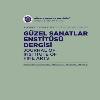Evaluation acreage, production and yield of Wheat (T. aestivum L.) by krigging method in Turkey
Türkiye'de Buğday (T. aestivum L.) ekim alanı, üretim ve veriminin krigging yöntemi ile değerlendirmesi
___
- Acevedo E, Fereres E (1993) Resistance to abiotic stress. In Hayward MD, Bosemark NO, Romagoza I (eds) Plant Breeding Principles and Prospects, Chapman and Hall. London, U.K., pp 406-421.
- Altınbaş M, Tosun M, Yüce S, Konak C, Köse E, Can RA (2004) Effects of genotype and location on the grain yield and some quality traits in bread wheats (T.aestivum L.). Ege Üniv. Ziraat Fak. Dergisi 41 (1): 65-74
- Anonymous (2006) FAO (Food and Agriculture Organization of the United Nations) 2006 FAO Statistical Databases Available from: http://faostat.fao.org Anonymous (2012) TUIK (Turkey Statistical Institution) TUIK Statistical Databases Available from: http://tuik.gov.tr
- Charles R, Jolliet O, Gaillard G, Pellet D (2006) Environmental analysis of intensity level in wheat crop production using life cycle assessment. Agriculture, Ecosystems and Environment 113: 216225
- CIMMYT (1996) CIMMYT 199596 world wheat facts and trends: understanding global trends in the use of wheat diversity and international flows of wheat genetic resources. Mexico, DF.
- Cook RJ, Veseth RJ (1991) Wheat health management. The American Phytopathological Society, St. Paul, Minnesota 55121, USA.
- Curtis BC (2002) Wheat in the world. In Curtis BC, Rajaram S, Gómez H, Macpherson (eds) Bread wheat ımprovement and production, FAO Plant Production and Protection Series, ISBN 92-5-104809-6, pp 12-29
- Curtis BC (1982) Potential for a yield increase in wheat. In Beltsville MD (ed) Proc. Natl. Wheat Res. Conf. National Association of Wheat Growers Foundation, USA, 26-28 Oct., Washington, DC, pp 5-19.
- Dalrymple DG (1986) Development and spread of highyielding varieties of wheat in developing countries. Washington, DC, Bureau for Science and Technology, Agency for International Development, US Government Printing Office.
- Erdogan S (2010) Modelling the spatial distribution of dem error with geographically weighted regression: an experimental study. Computers and Geosciences 36: 3443.
- Fischer RA, Maurer R (1978) Drought resistance in spring wheat cultivars. I. Grain yield responses. Aust J. Agric Res 29: 897-912.
- Jones G, Davis R (2000) Using a synoptic climatological approach to understand climate viticulture relationships. International Journal of Climatology 20: 813-837.
- Kanbertay M (1994) Ege Bölgesinde altı yerde yetiştirilen on ekmeklik buğday çeşidinin verim ve kalite yönünden incelenmesi. Bitki Islahı Bildirileri (Cilt II). Tarla Bitkileri Kongresi, 25-29 Nisan 1994, İzmir, s 34-37.
- Keser M, Bolat N, Altay F, Çetinel MT, Çolak N, Sever AL (1999) Çeşit geliştirme çalışmalarında bazı stabilite parametrelerinin kullanımı. Orta Anadolu Hububat Tarımını Sorunları ve Çözüm Yolları Semp. Konya s 64-69.
- Leonard WH, Martin JH (1963) Cereal crops. New York, NY, USA, MacMillan Publishing.
- Orth RA, Shellenberger JA (1988) Origin, production, and utilisation of wheat. In Pomeranz Y (ed) Wheat chemistry and technology. 3. St Paul, MN, USA, American Association of Cereal Chemists.
- Partigöç F, Olgun M (1999) Bazı buğday çeşitlerinde verim stabilitesi üzerine bir araştırma. Orta Anadolu Hububat Tarımını Sorunları ve Çözüm Yolları Semp., Konya, s 597-601.
- Percival J (1921) The wheat plant. A monograph. New York, NY, USA, E.P. Dutton & Company.
- Peterson RF (1965) Wheat botany, cultivation and utilization. New York, NY, USA, Interscience Publishers.
- Richards RA, Rebetzke GJ, Condon AG, van Herwaarden AF (2002) Breeding opportunities for ıncreasing the efficiency of water use and crop yield in temperate cereals. Crop Sci 42:111121.
- Tuğay ME (2012) Türk tarımında bitkisel üretimi artırma yolları. Tarım Bilimleri Araştırma Dergisi 5 (1): 0108.
- Tuğay ME, Akdağ C (1989) Türkiye iklim ve tarım bölgeleri. Sivas Yöresinde Tarımın Geliştirilmesi Sempozyumu, 30 Mayıs-3 Haziran, Sivas.
- Yılmaz A, Dönmez Ö, Kınacı E (1993) Konya hububat tarımında bazı yetiştirme tekniklerinin önemi. Konyada Hububat Tarımının Sorunları ve Çözüm Yolları Sempozyumu, 12-14 Mayıs, Konya, s 98-109.
- ISSN: 2146-1880
- Yayın Aralığı: Yılda 2 Sayı
- Başlangıç: 2000
- Yayıncı: Artvin Çoruh Üniversitesi Orman Fakültesi
Mustafa VAR, Banu BEKCİ, Gaye TAŞKAN
Mutfak mekânında kullanılan tezgâh malzemelerinin kullanıcı tercihleri açısından incelenmesi
Kuraklık stresine karşı borun antioksidant enzimlere etkisi
Evaluation acreage, production and yield of Wheat (T. aestivum L.) by krigging method in Turkey
İmren KUTLU, Zekiye BAŞÇİFTÇİ BUDAK, Murat OLGUN, Nazife Gözde AYTER, Saffet EROĞAN
Kabin tipi demonte mobilyalarda birleştirmelerin eğilme momenti üzerine kavela ve minifiksin etkisi
Kırka (Eskişehir) ve çevresinin damarlı bitki florası
Hasan Hüseyin DERE, Ö. Koray YAYLACI, Filiz SAVAROĞLU, Okan SEZER, Onur KOYUNCU, Kurtuluş ÖZGİŞİ, Derviş ÖZTÜRK
Fındık kabuklarının polipropilen esaslı polimer kompozit üretiminde değerlendirilmesi
Hüseyin PEKER, Mürşit TUFAN, Selçuk AKBAŞ, Türker GÜLEÇ, Cihat TAŞCIOĞLU
